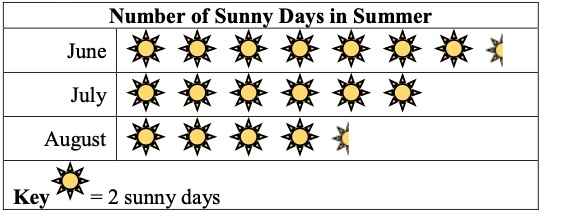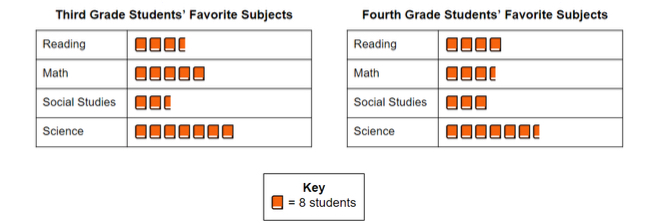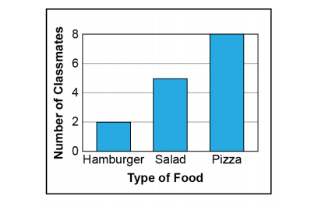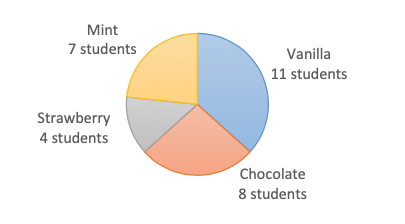Interpret data with whole-number values represented with tables, scaled pictographs, circle graphs, scaled bar graphs or line plots by solving one- and two-step problems.
Problems include the use of data in informal comparisons between two data sets in the same units.
| Name |
Description |
| Post-Hurricane Power Line Inspections | Students will solve real-world problems involving elapsed time to develop a plan for drone inspectors to survey power lines after a hurricane.
This is an open-ended engineering design lesson where students will develop a model to help them solve a problem. There are no “right” answers as the lesson is focused on the process of developing a solution and the skills and reasoning behind the process. Students should be given the freedom to interpret the problem and parameters in unique ways to pursue their own lines of thinking in producing a solution. |
| How does Generative AI work? | Students will explore Artificial Intelligence (AI) and the basics on how generative AI models use Large Language Models (LLMs) and Natural Language Processing NLP to generate outputs. This K-3 lesson is an integrated Computer Science, ELA and Math lesson designed for application of math and ELA content knowledge while exploring and using computational thinking to understand how generative AI works, making cross-curricular connections to understand emerging technologies. |
| U.S. Symbols Construction | Students will interpret and make comparisons of construction start and end dates and heights of U.S. symbols. Students will solve one- and two-step word problems based on the data. |
| Graph the Election 2 | Students will conduct an election and learn about the structure and functions of the government. With election data, students will represent data and graph the data. Math and Civics are in this integrated lesson plan. |
| Fractions and Civics 3 | Students will conduct surveys, tally results, and represent the data on graphs. In this lesson, students will also represent data in fractions, equivalent fractions and learn how citizens demonstrate civility, cooperation, volunteerism and other civic virtues. Math and Civics are integrated in this lesson plan. |
| How Many Years? | Students will discuss what they know about individuals who represent the U.S. or Florida and interpret data including important dates in the lives of these individuals. Students will use the data to solve one and two-step word problems in this integrated lesson. |
| U.S. Images Data Sort | Students will determine ways to categorize images of symbols, individuals and documents that represent the United States to create a table of their data. Using the table students will create a scaled pictograph in this integrated lesson plan. |
| Help, Collect, Plot! | In this lesson plan, students will collect numerical data on a school-based food drive and represent and interpret the the data using line plots. The students will demonstrate volunteerism by donating to the community. |
| I Vote, You Vote, We Vote | In this lesson, students will analyze voting data and perform mathematical procedures to determine the answer to specific questions. Students will compare the population of the community vs. the number of votes counted. Students will discuss the contribution each citizen is making when voting and the effects on the results when citizens do not vote. |
| Going to the Dogs? | In this integrated lesson plan, students will use their knowledge of collecting and interpreting data as they participate in a hypothetical election based on the controversy of whether or not their community should have a leash law. Students will be given background knowledge of the differences between state and local governments, and how laws are enacted, in particular, “leash laws” for dogs. The students will vote, tally the results, and use a frequency table to create a bar graph determining the range, title, and labels. Students will then interpret the election results while answering one- and two-step problems based on their bar graphs while demonstrating their knowledge of different levels of government and the importance of voting in local elections. |
| Food Drive | A data table is given listing class donations to a food drive. Students interpret the data and answer questions using addition and subtraction. Students discuss the importance of, volunteerism and ways that they can help their community. |
| Raising the Bar | Students will create and interpret bar graphs using tally mark data from a table. Students will also discuss and understand the implications of our civic duty to vote, and how this affects data for polls and decision-making, in this integrated lesson plan. |
| Graphs Your Way! | In this lesson students go on a field trip around the school. They will collect data from adults about their favorite movie and from children about their favorite video game. They will use this information to construct their own scaled horizontal/vertical bar graphs or scaled pictographs. They will write situational stories/questions to accompany their graphs. They will also collaborate with their peers to compare and contrast a pictograph with a bar graph. |
| Cuts In A Rush | In this time rush to get a haircut, students will add elapsed time to find the total time spent at the hair salon and the time of departure from the salon. They must use this information determine which salon is the best for the new family in the neighborhood. Students will submit a letter to the client explaining their procedure for ranking the hair salons.
Model Eliciting Activities, MEAs, are open-ended, interdisciplinary problem-solving activities that are meant to reveal students’ thinking about the concepts embedded in realistic situations. MEAs resemble engineering problems and encourage students to create solutions in the form of mathematical and scientific models. Students work in teams to apply their knowledge of science and mathematics to solve an open-ended problem while considering constraints and tradeoffs. Students integrate their ELA skills into MEAs as they are asked to clearly document their thought processes. MEAs follow a problem-based, student-centered approach to learning, where students are encouraged to grapple with the problem while the teacher acts as a facilitator. To learn more about MEAs visit: https://www.cpalms.org/cpalms/mea.aspx |
| Florida Fish Aquarium Challenge | This task involves having students look at three different fish tank sizes and determine, using a data list, which fish will fit in these fish tanks based on their size. They will also need to look at other characteristics to determine how to group the fish together. Students will have to either multiply, divide or add repeatedly in order to find different solutions on how to place the fish in each tank size.
Model Eliciting Activities, MEAs, are open-ended, interdisciplinary problem-solving activities that are meant to reveal students’ thinking about the concepts embedded in realistic situations. MEAs resemble engineering problems and encourage students to create solutions in the form of mathematical and scientific models. Students work in teams to apply their knowledge of science and mathematics to solve an open-ended problem, while considering constraints and tradeoffs. Students integrate their ELA skills into MEAs as they are asked to clearly document their thought process. MEAs follow a problem-based, student centered approach to learning, where students are encouraged to grapple with the problem while the teacher acts as a facilitator. To learn more about MEA’s visit: https://www.cpalms.org/cpalms/mea.aspx |
| Sweet Donut Shop | In this Model Eliciting Activity, MEA, students will help the Sweet Donut Shop determine what the newest donut will be. Students are given the cost to make each batch along with the selling price and are asked to determine the profit for each batch. Students create a procedure for ranking the donuts and write a letter explaining the procedure and the ranking. In the “twist” students are provided the starting and finishing times for each batch. They must determine the total amount of time, decide if their procedure should change based on the new information, and write a letter explaining whether the procedure changed and the new ranking of the donuts.
Model Eliciting Activities, MEAs, are open-ended, interdisciplinary problem-solving activities that are meant to reveal students’ thinking about the concepts embedded in realistic situations. MEAs resemble engineering problems and encourage students to create solutions in the form of mathematical and scientific models. Students work in teams to apply their knowledge of science and mathematics to solve an open-ended problem, while considering constraints and tradeoffs. Students integrate their ELA skills into MEAs as they are asked to clearly document their thought process. MEAs follow a problem-based, student centered approach to learning, where students are encouraged to grapple with the problem while the teacher acts as a facilitator. To learn more about MEA’s visit: https://www.cpalms.org/cpalms/mea.aspx |
| X Marks the Spot! | In this lesson, students will make multiple measurements and record the measurements on a line plot. |
| This Is My Country | Students will collect and represent categorical data (countries or states/districts of birth of third graders) on a scaled bar graph using an appropriate title, labels, and units. They will interpret and discuss the data by writing and solving one-step problems. It is suggested the students later use this same data to create a scaled pictograph and then compare the two representations. |
| Raja Rangoli | Rangoli is a traditional Indian art that is used in decorating the entrance of the house to welcome guests. In this activity students will use the concept of lines of symmetry to select the best rangoli design for a school event.
Model Eliciting Activities, MEAs, are open-ended, interdisciplinary problem-solving activities that are meant to reveal students’ thinking about the concepts embedded in realistic situations. MEAs resemble engineering problems and encourage students to create solutions in the form of mathematical and scientific models. Students work in teams to apply their knowledge of science and mathematics to solve an open-ended problem while considering constraints and tradeoffs. Students integrate their ELA skills into MEAs as they are asked to clearly document their thought processes. MEAs follow a problem-based, student-centered approach to learning, where students are encouraged to grapple with the problem while the teacher acts as a facilitator. To learn more about MEAs visit: https://www.cpalms.org/cpalms/mea.aspx |
| Animal Habitat MEA | Animal Habitat MEA is where the students will help a pet store choose which habitat they should buy to house their snake and lizard families. The students will solve an open-ended problem and give details on the process that they used to solve the problem.
Model Eliciting Activities, MEAs, are open-ended, interdisciplinary problem-solving activities that are meant to reveal students’ thinking about the concepts embedded in realistic situations. MEAs resemble engineering problems and encourage students to create solutions in the form of mathematical and scientific models. Students work in teams to apply their knowledge of science and mathematics to solve an open-ended problem, while considering constraints and tradeoffs. Students integrate their ELA skills into MEAs as they are asked to clearly document their thought process. MEAs follow a problem-based, student centered approach to learning, where students are encouraged to grapple with the problem while the teacher acts as a facilitator. To learn more about MEA’s visit: https://www.cpalms.org/cpalms/mea.aspx |
| Healthy Habits | In this Model Eliciting Activity, MEA, students will determine what two snacks should be placed in the school vending machines because the district is asking for healthier and tastier snacks. Factors to consider are calories, fat, protein, sugar, student comments, and cost.
Model Eliciting Activities, MEAs, are open-ended, interdisciplinary problem-solving activities that are meant to reveal students’ thinking about the concepts embedded in realistic situations. MEAs resemble engineering problems and encourage students to create solutions in the form of mathematical and scientific models. Students work in teams to apply their knowledge of science and mathematics to solve an open-ended problem, while considering constraints and tradeoffs. Students integrate their ELA skills into MEAs as they are asked to clearly document their thought process. MEAs follow a problem-based, student-centered approach to learning, where students are encouraged to grapple with the problem while the teacher acts as a facilitator. To learn more about MEA’s visit: https://www.cpalms.org/cpalms/mea.aspx
|
| Dining Dilemma! | In this Model Eliciting Activity, MEA, students will compare different nutritional content of chicken nuggets from many restaurants presented in bar graphs. They will factor in the calories, total fat, and sodium information about the nuggets to create a procedure for ranking the nuggets from healthiest to least healthy.
Model Eliciting Activities, MEAs, are open-ended, interdisciplinary problem-solving activities that are meant to reveal students’ thinking about the concepts embedded in realistic situations. MEAs resemble engineering problems and encourage students to create solutions in the form of mathematical and scientific models. Students work in teams to apply their knowledge of science and mathematics to solve an open-ended problem, while considering constraints and tradeoffs. Students integrate their ELA skills into MEAs as they are asked to clearly document their thought process. MEAs follow a problem-based, student centered approach to learning, where students are encouraged to grapple with the problem while the teacher acts as a facilitator. To learn more about MEA’s visit: https://www.cpalms.org/cpalms/mea.aspx
|
| Picking Pets | Using information about the needs of different animals, students will help choose which pet would be best to purchase for a classroom.
Model Eliciting Activities, MEAs, are open-ended, interdisciplinary problem-solving activities that are meant to reveal students’ thinking about the concepts embedded in realistic situations. MEAs resemble engineering problems and encourage students to create solutions in the form of mathematical and scientific models. Students work in teams to apply their knowledge of science and mathematics to solve an open-ended problem, while considering constraints and tradeoffs. Students integrate their ELA skills into MEAs as they are asked to clearly document their thought process. MEAs follow a problem-based, student centered approach to learning, where students are encouraged to grapple with the problem while the teacher acts as a facilitator. To learn more about MEA’s visit: https://www.cpalms.org/cpalms/mea.aspx |
| Cars for Sale MEA | Students will compare multi-digit numbers to create a procedure for choosing the best car for Edward Easy to buy for his driving school. They will have to weigh quantitative and qualitative factors to determine the best car to purchase. Students will present their recommendations and the steps to the procedure they created in writing and orally.
Model Eliciting Activities, MEAs, are open-ended, interdisciplinary problem-solving activities that are meant to reveal students’ thinking about the concepts embedded in realistic situations. MEAs resemble engineering problems and encourage students to create solutions in the form of mathematical and scientific models. Students work in teams to apply their knowledge of science and mathematics to solve an open-ended problem, while considering constraints and tradeoffs. Students integrate their ELA skills into MEAs as they are asked to clearly document their thought process. MEAs follow a problem-based, student centered approach to learning, where students are encouraged to grapple with the problem while the teacher acts as a facilitator. To learn more about MEA’s visit: https://www.cpalms.org/cpalms/mea.aspx |
| Lunchroom Logistics | The principal needs help planning the school lunch schedule! Students will plan a lunch schedule to accommodate all of the students in the school. However, there can only be 100 students in the cafeteria at a time and only 20 students can sit at a table. Students will figure out how to arrange the lunch schedule so that every class eats together and so that certain grade levels are not together at the same time.
Model Eliciting Activities, MEAs, are open-ended, interdisciplinary problem-solving activities that are meant to reveal students’ thinking about the concepts embedded in realistic situations. MEAs resemble engineering problems and encourage students to create solutions in the form of mathematical and scientific models. Students work in teams to apply their knowledge of science and mathematics to solve an open-ended problem while considering constraints and tradeoffs. Students integrate their ELA skills into MEAs as they are asked to clearly document their thought processes. MEAs follow a problem-based, student-centered approach to learning, where students are encouraged to grapple with the problem while the teacher acts as a facilitator. To learn more about MEAs visit: https://www.cpalms.org/cpalms/mea.aspx |





